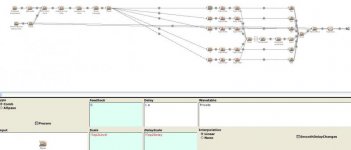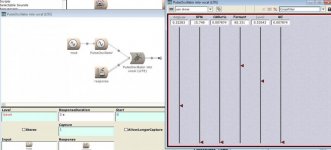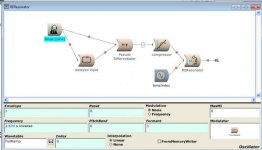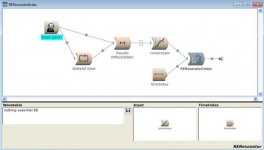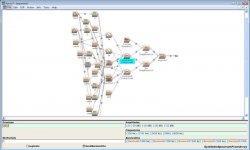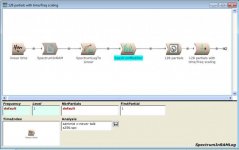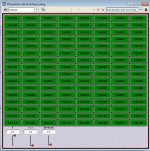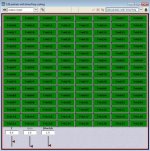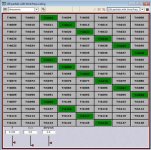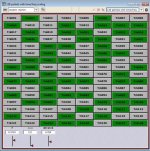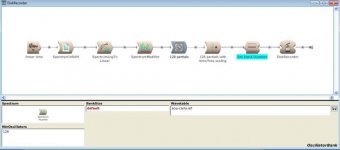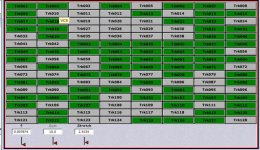Install the app
How to install the app on iOS
Follow along with the video below to see how to install our site as a web app on your home screen.
Note: This feature may not be available in some browsers.
You are using an out of date browser. It may not display this or other websites correctly.
You should upgrade or use an alternative browser.
You should upgrade or use an alternative browser.
Kyma X - Pacarana
- Thread starter roland kuit
- Start date
Naar aanleiding van deze draad:
https://www.synthforum.nl/forums/showthread.php?p=1769707#post1769707
plaatste WaveGuide7 een prachtige demonstratie hier:
https://www.synthforum.nl/forums/showpost.php?p=1769682&postcount=610
Ik heb hier een Crossfilter voorbeeld.
De Sample is spraak. "1,2,3". De crossfilter krijgt resonantie 'tikjes' uit een pulse oscillator. Wanneer ik de modulatie index verhoog ontstaat er een soort reverb/delay effect.
https://www.synthforum.nl/forums/showthread.php?p=1769707#post1769707
plaatste WaveGuide7 een prachtige demonstratie hier:
https://www.synthforum.nl/forums/showpost.php?p=1769682&postcount=610
Ik heb hier een Crossfilter voorbeeld.
De Sample is spraak. "1,2,3". De crossfilter krijgt resonantie 'tikjes' uit een pulse oscillator. Wanneer ik de modulatie index verhoog ontstaat er een soort reverb/delay effect.
Attachments
http://www.symbolicsound.com/cgi-bin/bin/view/Company/WebHome
Bovenaan zie "order".
Vergeet niet dat de Douane +/- E700,- opvreet. Dat komt er extra bij als importkosten.
Je stuurt eender welke kapotte print 'voor herstelling' naar de USA.
De leverancier stuurt dan 'de herstelling' terug.
Geen BTW, geen invoerrechten.

Resonator/Exciter (RE) Analysis
RE analysis is an alternative form of spectral analysis that employs subtractive,
rather than additive, synthesis as the resynthesis technique. The result of an RE
analysis is a spectral envelope in the form of a file containing filter parameters
that are updated over time. When you feed a broadband signal into this filter,
you hear the spectral envelope of your original sample imposed on the broadband
input. RE synthesis is similar to the idea of vocoding with one important
difference; a vocoder uses a large number of simple bandpass filters, whereas
RE synthesis uses one filter that has several (time-varying) peaks in its
response.
Nothing happens in the absence of noise 1:
Na het aanmaken van een RE file die als wavetable voor de Reresonator fungeert:
REResonator
Filters Category
This is a time-varying filter whose coefficients have been derived by analyzing a digital recording (a "sample") using
the RE Analysis Tool. RE (resonator/exciter) analysis assumes that the sound was produced by an excitation signal
feeding into a resonator. This Sound is the resonator and its input is the excitation.
The most striking results occur when the analyzed signal is from a source whose resonances change dramatically
over time (e.g. human speech, singing, instruments like the didgeridoo, mouth harp, or tabla). For analyses of
instruments or other sound
In het audio voorbeeld hoor je dat ik met de frequentie van de oscillator speel, dit veranderd de snelheid van de spraak.
RE analysis is an alternative form of spectral analysis that employs subtractive,
rather than additive, synthesis as the resynthesis technique. The result of an RE
analysis is a spectral envelope in the form of a file containing filter parameters
that are updated over time. When you feed a broadband signal into this filter,
you hear the spectral envelope of your original sample imposed on the broadband
input. RE synthesis is similar to the idea of vocoding with one important
difference; a vocoder uses a large number of simple bandpass filters, whereas
RE synthesis uses one filter that has several (time-varying) peaks in its
response.
Nothing happens in the absence of noise 1:
Na het aanmaken van een RE file die als wavetable voor de Reresonator fungeert:
REResonator
Filters Category
This is a time-varying filter whose coefficients have been derived by analyzing a digital recording (a "sample") using
the RE Analysis Tool. RE (resonator/exciter) analysis assumes that the sound was produced by an excitation signal
feeding into a resonator. This Sound is the resonator and its input is the excitation.
The most striking results occur when the analyzed signal is from a source whose resonances change dramatically
over time (e.g. human speech, singing, instruments like the didgeridoo, mouth harp, or tabla). For analyses of
instruments or other sound
In het audio voorbeeld hoor je dat ik met de frequentie van de oscillator speel, dit veranderd de snelheid van de spraak.
Attachments
Stel nu dat is met de hand door de wavetable loop. Dan kan ik op welk willekeuring moment stoppen of de spraak wavetable stilzetten.
Wat resulteerd in een 'hold' op de filtercoëfficiënten.
Nothing happens in the absence of noise 2:
Wat resulteerd in een 'hold' op de filtercoëfficiënten.
Nothing happens in the absence of noise 2:
Attachments
In het audio voorbeeld hoor je dat ik met de frequentie van de oscillator speel, dit veranderd de snelheid van de spraak.
Dat betekend de snelheide waarmee de wavetable gelezen wordt, en daardoor ook de veranderingen in filtercoëfficiënten.
WaveGuide7
Gedeactiveerd account
- Lid sinds
- 12 november 2009
- Berichten
- 1.152
De filtercoefficienten veranderen niet bij tijdopschaling; alleen het aantal samples dat je naar het LPC-filter stuurt wordt groter of kleiner.
Even wachten, bedoel je dat er alleen sneller 'piekpunten' ontstaan?
"a time-varying filter whose coefficients have been derived by analyzing a digital recording":
dit betekend toch dat ik door deze coefficients kan 'scrubben'?
Wavetable
This is a table of time-varying filter coefficents produced by the RE analysis. Use the RE Analysis Tool to create your
own sets of filter coefficients.
TimeIndex
This determines where to read from the sequence of filter coefficients. A value of -1 reads the beginning set of
coefficients, and a value of 1 reads the last set of coefficients. A FunctionGenerator whose wavetable is a FullRamp
will go through the coefficients in time order. To go through the coefficients at the original rate, set the duration of the
FunctionGenerator to be the same as the duration of the original, analyzed sample. Use longer or shorter durations
to stretch or compress time.
"a time-varying filter whose coefficients have been derived by analyzing a digital recording":
dit betekend toch dat ik door deze coefficients kan 'scrubben'?
Wavetable
This is a table of time-varying filter coefficents produced by the RE analysis. Use the RE Analysis Tool to create your
own sets of filter coefficients.
TimeIndex
This determines where to read from the sequence of filter coefficients. A value of -1 reads the beginning set of
coefficients, and a value of 1 reads the last set of coefficients. A FunctionGenerator whose wavetable is a FullRamp
will go through the coefficients in time order. To go through the coefficients at the original rate, set the duration of the
FunctionGenerator to be the same as the duration of the original, analyzed sample. Use longer or shorter durations
to stretch or compress time.
WaveGuide7
Gedeactiveerd account
- Lid sinds
- 12 november 2009
- Berichten
- 1.152
Wat ze hier bedoelen met "Resonator/Exciter (RE) Analysis" is natuurlijk niets anders dan LPC: een parametrische spectraalanalyse. Dit is een frame-gebaseerde techniek: neem een kort geluidsfragment en reken dat om naar een filter (d.w.z. een aantal filtercoëfficiënten). Een lang geluid wordt dus opgedeeld in een set van frames, die elk een uniek, eigen filter opleveren.
De filtercoëfficiënten kunnen niet veranderen! De resultaten van de analyse-fase zijn statisch, tijdinvariant. Wat wèl kan (en wat waarschijnlijk ook gebeurt) is dat er in de synthese-fase een lineaire interpolatie plaats vindt tussen de filtercoëfficiënten van twee naburige frames. Ik doe dat in elk geval in WaveWizard. Zou je niet interpoleren dan zou de output rauw en granulair gaan klinken. Dus ja, er wordt in de synthese-fase uit statische filters iets tijdvariants gebrouwd, daar heb je wel gelijk in. Maar dat neemt het hap-hapkarakter van de analyse niet weg. Na elk frame begint LPC weer als een pasgeboren baby: het heeft geen enkel idee van een verleden of een toekomst. Trekt ook geen "lering" uit het verleden. Het kan allemaal ook heel anders: denk aan het Kalmanfilter.
De filtercoëfficiënten kunnen niet veranderen! De resultaten van de analyse-fase zijn statisch, tijdinvariant. Wat wèl kan (en wat waarschijnlijk ook gebeurt) is dat er in de synthese-fase een lineaire interpolatie plaats vindt tussen de filtercoëfficiënten van twee naburige frames. Ik doe dat in elk geval in WaveWizard. Zou je niet interpoleren dan zou de output rauw en granulair gaan klinken. Dus ja, er wordt in de synthese-fase uit statische filters iets tijdvariants gebrouwd, daar heb je wel gelijk in. Maar dat neemt het hap-hapkarakter van de analyse niet weg. Na elk frame begint LPC weer als een pasgeboren baby: het heeft geen enkel idee van een verleden of een toekomst. Trekt ook geen "lering" uit het verleden. Het kan allemaal ook heel anders: denk aan het Kalmanfilter.
nlight
Stamgast
Bijna poëzie, maar ik haak even af… 

Ok, dan wandel ik door de frames. Bedankt voor je uiteg WaveGuide7!
WaveGuide7
Gedeactiveerd account
- Lid sinds
- 12 november 2009
- Berichten
- 1.152
Biedt Kyma een keuze voor de cascade- en/of parallelvorm van het filter? En buisdiameters?
SyntheticSpectrumFromArray
Spectral Sources Category
Creates a synthetic spectrum from two arrays: an array of amplitude values for each track in the frame, and an array
of frequency values for each track in the frame (and, if SendBandwidths is checked, a corresponding array of
bandwidths for each of the tracks as well). A SyntheticSpectrumFromArray should be fed to an OscillatorBank,
FormantBankOscillator, or VocoderChannelBank in order to synthesize the partials, formants, or bank of vocoder
filters. The SyntheticSpectrumFromArray produces a set of envelopes for controlling the parameters of an
OscillatorBank, FormantBankOscillator, or VocoderChannelBank.
Op de foto (zie beneden) 1 van de Spectra en hoe dat is ingericht: Amplitudes, Fequenties en Bandwidths. Verder een random invulling van de 'voice' spectra:
Spectral Sources Category
Creates a synthetic spectrum from two arrays: an array of amplitude values for each track in the frame, and an array
of frequency values for each track in the frame (and, if SendBandwidths is checked, a corresponding array of
bandwidths for each of the tracks as well). A SyntheticSpectrumFromArray should be fed to an OscillatorBank,
FormantBankOscillator, or VocoderChannelBank in order to synthesize the partials, formants, or bank of vocoder
filters. The SyntheticSpectrumFromArray produces a set of envelopes for controlling the parameters of an
OscillatorBank, FormantBankOscillator, or VocoderChannelBank.
Op de foto (zie beneden) 1 van de Spectra en hoe dat is ingericht: Amplitudes, Fequenties en Bandwidths. Verder een random invulling van de 'voice' spectra:
Attachments
Biedt Kyma een keuze voor de cascade- en/of parallelvorm van het filter? En buisdiameters?
De eerste 2 wel, de 3de weet ik nog niet. Ik moet nog zoveel uitzoeken in Kyma(erg leuk dus).
Stel dat je een zang spectrum in 128 sinusbank kan stoppen:
SpectrumInRAMLog
This Sound is used only as the Spectrum input to an OscillatorBank.
It reads an analysis file that contains a series of spectra indexed by TimeIndex. It outputs a spectrum as a sequence of (amplitude,frequency) pairs on every sample tick for nbrPartials samples. After nbrPartials samples, it starts over again from the fundamental and outputs the entire spectrum again.
OscillatorBank
Generates the sum of several oscillators on the specified waveform, each with its own frequency and amplitude envelope.
NbrOscillators
This is the number of oscillators that will be added together. Each oscillator is associated with a partial from the time-varying spectrum given in the Spectrum field.
Met de patch en de Deauft sound:
SpectrumInRAMLog
This Sound is used only as the Spectrum input to an OscillatorBank.
It reads an analysis file that contains a series of spectra indexed by TimeIndex. It outputs a spectrum as a sequence of (amplitude,frequency) pairs on every sample tick for nbrPartials samples. After nbrPartials samples, it starts over again from the fundamental and outputs the entire spectrum again.
OscillatorBank
Generates the sum of several oscillators on the specified waveform, each with its own frequency and amplitude envelope.
NbrOscillators
This is the number of oscillators that will be added together. Each oscillator is associated with a partial from the time-varying spectrum given in the Spectrum field.
Met de patch en de Deauft sound:
Attachments
Een andere test.
Afgelopen voorbeelden bestond de Oscillatorbank uit 128 sinussen die het spectrum van de zang aannamen.
In het volgende voorbeeld heb ik de sinus vervangen door een vrouwenstem:
Laat Harry Potter nu maar komen
Afgelopen voorbeelden bestond de Oscillatorbank uit 128 sinussen die het spectrum van de zang aannamen.
In het volgende voorbeeld heb ik de sinus vervangen door een vrouwenstem:
Laat Harry Potter nu maar komen

Attachments
A friend of mine is selling his almost brand new Pacarana:
http://www.ebay.it/itm/Symbolic-Sou...0?pt=LH_DefaultDomain_101&hash=item3a9b8244b8
Het is wel, of niet je ding.
http://www.ebay.it/itm/Symbolic-Sou...0?pt=LH_DefaultDomain_101&hash=item3a9b8244b8
Het is wel, of niet je ding.
Vergelijkbare discussies
Delen:
